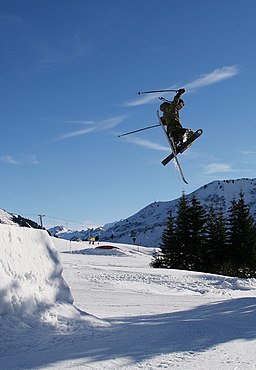| [[File:SprüngeDamüls12.jpg|SprüngeDamüls12]] |
Since skiing takes place on snow, it is necessary to decide how a camera is to be kept reasonably warm. batteries do not like low temperatures but lithium cells tend to be the most tolerant. Keep the camera inside clothing and close to the body when it is not in use. This gives the batteries time to rise in temperature by a few degrees.
Photographing skiers in action is not easy. One of the principal problems is that skiers moving at high speed make the best action shots because they throw up plumes of snow and adopt more interesting positions and angles. Blurring can therefore be a problem, but can also be used as a way on conveying the impression of speed. Light on ski slopes tends to be intense, so shutter speeds can usually be set fairly fast.
Photographers are well advised to use equipment with which they are thoroughly familiar. Standing in deep snow on a steep ski slope is no time to learn how to use a camera. light meters tend to underexpose in all-white surroundings, so take a spot reading off your hand or a grey card. However, modern matrix-metering systems are generally very accurate, so it is important to know the characteristics of a camera before doing too much work. Dress warmly and wear fingerless gloves which keep the hands warm but allow camera controls to be conveniently manipulated.
Another problem experienced on ski slopes is the lack of contrast. Everything is flat, smooth and white, so wherever possible include objects which provide some contrast. Daylight flash is also an asset because the intensity of the light reflected from a skier' suit may be considerably lower than that reflected by the snow. To avoid the skier being rendered dark or even black, a burst of fill-in flash may be required.
Perhaps the most valuable asset a photographer can have is the co-operation of a skier willing to perform for the camera in a predictable manner and location. It is then possible to arrange the best time of day and direction for the light. Finally, take lots of images. Events take place very rapidly on a ski slope so it is all too easy to miss the peak of the action.







